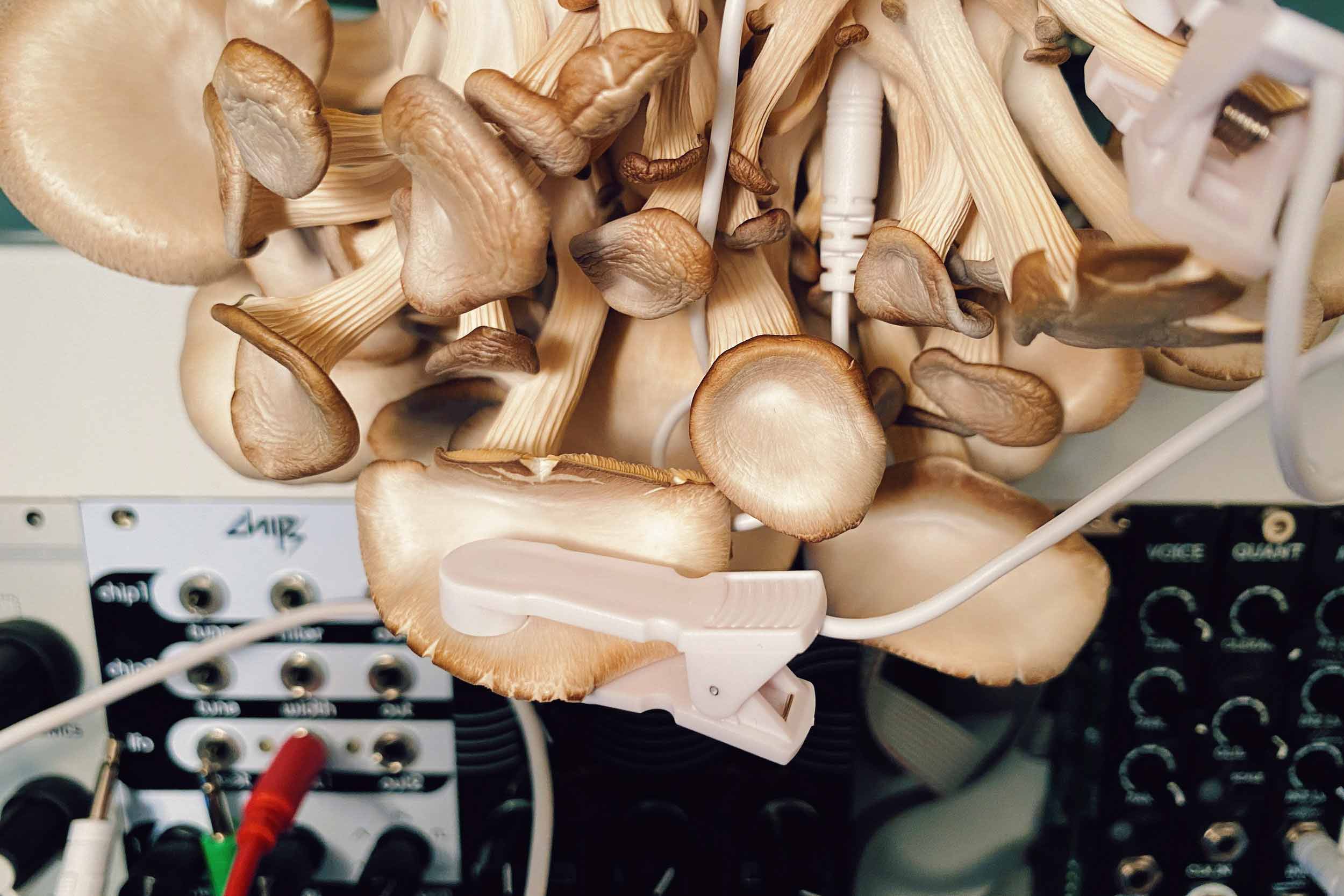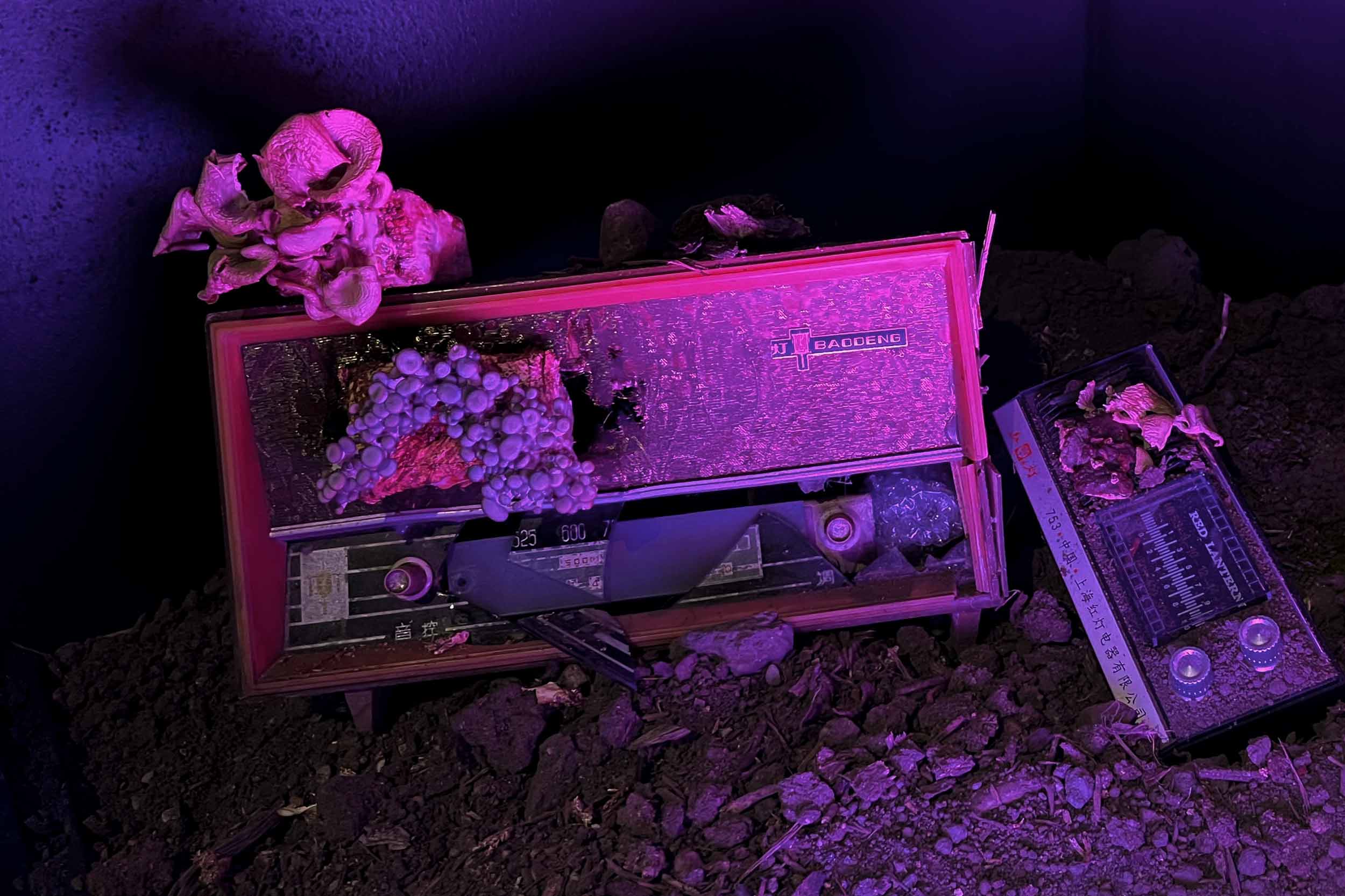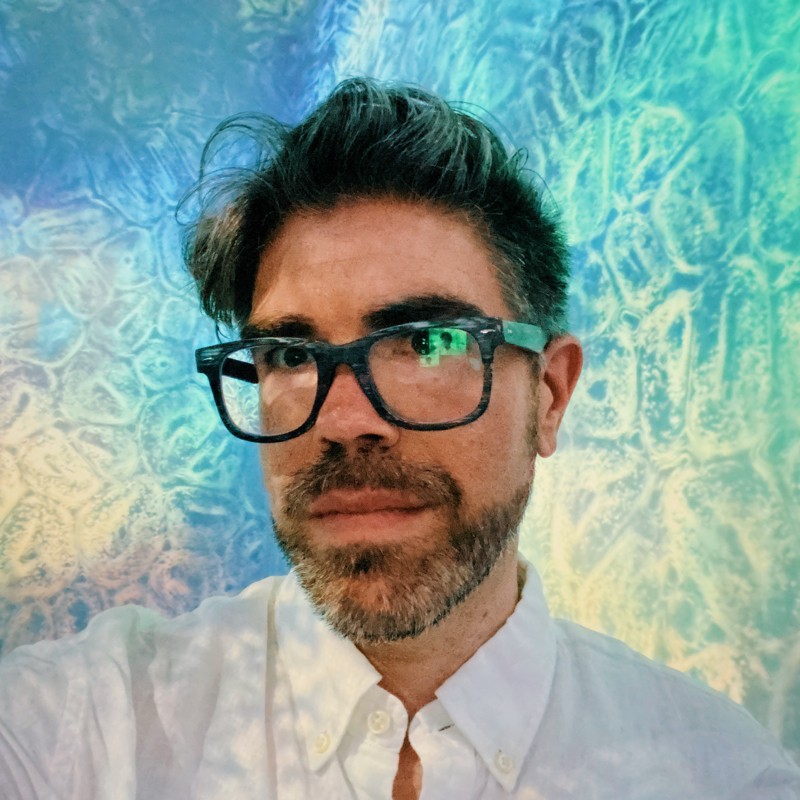06/09/2023
The Emergent Sound of Worlding: On listening to mushrooms
“Phototropic Response”, on Worlding: Sympoetic Mycology (Canada: No Type, 2022) by Eryk Salvaggio.
Mushrooms are entangling agents. Mycorrhizal fungi intertwine themselves with plant roots, creating symbiotic relationships. The artist and researcher Eryk Salvaggio entered into symbiosis with Oyster mushrooms by extending their entanglement with cables, translating the mushrooms’ communication patterns into the circuitry of an analog synthesiser. Recordings of communicating mushrooms resulted in the album Worlding: Sympoetic Mycology (Canada: No Type).
As a body without a centre, mycorrhizal network behaviours are coordinated through communication. Oyster mushrooms, for example, organise themselves through small voltage spikes, which carry signals through the network. Dr. Andrew Adamatzky, Director of the Unconventional Computing Laboratory at the University of the West of England, Bristol, has identified 50 patterns of spikes which remain consistent as they encounter familiar stimuli. This includes patterns in response to salt, heat, and light, distinct from those observed in other plants, or from the electric fields generated by most objects. The key difference is a grammatical organisation of these spikes, akin to a language. These spikes repeat in familiar patterns, functioning like words.
Worlding is a series of musical compositions created by linking the internal communication patterns of Oyster mushrooms to a modular, analog synthesiser. Mushrooms are a sprawling body — the caps emerging from the ground are just one extension of their underground exploration network. The network seeks food, favourable light conditions, and recoils from harm. It moves nutrients from one region to another, becoming entangled with the roots of plants and trees.
The title refers to a concept best defined in an essay by Helen Palmer and Vicky Hunter, summarising Kathleen Stewart, for whom it refers “to the ‘affective nature’ of the world in which ‘non-human agency’ comprising ‘forms, rhythms and refrains’ … reach a point of ‘expressivity’ for an individual and develop a sense of ‘legibility’. Through this process a particular ‘world’ emerges for the individual through their engagement with a number of interrelated phenomena.”
By extending this entanglement into cables, which carry the mushroom’s voltage into the circuitry of an analog synthesiser, a recording of this worlding becomes possible. The mushrooms’ signals are divided into low, low-medium, high-medium, and high intensity. Each signal then moves along a different path set by wires in the synthesiser to transform the shape, tone, and rhythms of the corresponding sonic output. Extending the network of the mushroom into synthesiser circuitry entangles the two. I set up the structures through which these signals flow, and I step aside. The sonic landscape transforms as the mushrooms grow and wither.

Recordings of various test structures for this soundscape were released as “Worlding: Sympoietic Mycology,” available on the Canadian music label, No Type. Photograph by Eryk Salvaggio.

This experiment was part of the design process for an art and science exhibition, 1.5 Degrees Celsius, at the Michigan State University Science Museum and Collaboratory. It was co-created with Claudia Westermann and Vinny Montag at Xi’an Jiaotong-Liverpool University. Photograph by Mark Sullivan.
Is the Oyster mushroom communicating with us?
Is the entanglement of the mushroom and the cabling an extension of the signal, or an artificial amplification? These questions are the purpose of entanglement as a design process. Rather than solving problems, we design to pose new questions, producing new orientations to relationships between non-human intelligences, and between human and non-human. The designer gets lost in the entanglement. I listen to the music, and through its rhythms, drones, and melodies, I find myself extending my own circle of empathy toward a silent, underground and oft-neglected species. What does mushroom music mean? Mushroom rhythms wander. The melodies are exploratory and responsive. They shift between calm and exuberant, depending on life cycle and environment. There is a calmness in the recordings where they are being misted with fresh water on a dry day. It’s there when I rest my hand softly on their caps, and the electrical field of my body flows through them in an even tighter embrace of this electrically connected ecosystem. When tiny bodies extend from their subterranean world – “pinning” — the sound is dense, vibrant, a high intensity signal exciting the circuit boards into quick cycling rhythms, pulsing and throbbing like dance music bursting at the high end of distortion. Towards the end of their life cycles, the electric flow decreases. The synthesiser produces drones, low electrical humming that could put me to sleep as the mushrooms fade.
This is a subjective interpretation and analysis of what may well be the ordering of random static through modules meant to organise electricity into sound. But all communication is interpretation. Words are gestures that point to ideas. You may read this in English, as I intended, or through a German interpretation. The words will not have the same shape on the page nor will they have the same semiotic associations. In either language I am limited by the selection of words available to me, and the limits of my own skill in crafting words that can convey anything at all.
Music creates a space for our own entanglement, creates space to wander with the ambiguity of mushroom expression through listening. George Saunders writes that “every soul is vast and wants to express itself fully. If it’s denied an adequate instrument (and we’re all denied that, at birth, some more than others), out comes… poetry, i.e., truth forced out through a restricted opening.”. We throw ourselves at the fence of language, Saunders adds, and poetry is the resulting bulging of the fence. It is impossible to “know” if the music makes a dent in the barriers that remain between human and nonhuman conversation. Here, it is music that emerges from an attempt: the synthesiser is a fence for the mushroom to push through. I created a structure for that sound, and I established a relationship to the mushroom through it. The rest is left to interpretation.
As I finished these recordings, I was left wondering if the entire world is speaking and responding to us. Something odd and beautiful may emerge from the speakers and the soil, if only through our desire to listen.
Adamatzky, A. (2022) Language of fungi derived from their electrical spiking activity. Royal Society.
Palmer, H. & Hunter, V. (2018) Worlding. In New Materialism: How Matter Comes to Matter.
Saunders, G. (2021) A Swim in a Pond in the Rain. Random House. p.287
Your Comments
Explore more

0 Comments